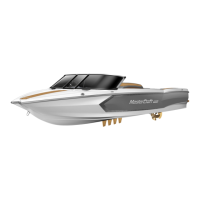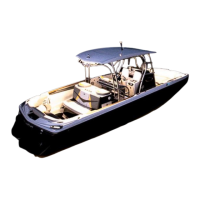MASTERCRAFT TRAILERS
26-3
The Trailer Hitch
There are two basic types of trailer hitches: A weight-carrying
hitch and a weight-distributing hitch. A weight-carrying hitch is recom-
mended for your MasterCraft. Before deciding which type of hitch to
use, also consult your automobile manufacturer on recommendations
for your car or truck.
Be sure that the total weight of your trailer-boat rig does not ex-
ceed the hitch’s load capacity. The maximum weight it can handle is
stamped on the hitch. Also, be sure the hitch ball is the correct size to
match the coupler on your trailer. The correct ball diameter is marked
on the trailer coupler. The hitch also should provide a place for at-
taching the trailer’s safety cables–two rings or holes on either side of
the hitch ball.
A truck or van using a step bumper as the hitch platform will need
to have safety cable attachments such as eye-bolts, as well as a hitch
ball, installed according to the Society of Automotive Engineers; SAE
J684 Standard. Installing a light or heavy-duty hitch can be a major
undertaking. The hitch and its installation should meet the SAE J684
Standard. It is recommended that you have the job done by a profes-
sional. Your dealer can advise you.
To ensure that the boat is riding properly on the trailer supports, the trailer should be in a level position
when hitched to the tow vehicle. The recommended height of the hitch ball, according to the NMMA, is 16-to-
20 inches to the top of the ball from the ground. More importantly, failure to adjust to this height may prema-
turely activate the surge brakes.
This can be corrected in a number of different ways. For example, you may install air-pressure adjustable
shock absorbers on the tow vehicle, or switch from a weight-carrying hitch to a weight-distributing hitch. Again,
consult with your tow vehicle dealer.
In general, for Class 3 rigs (3,500 to 5,000 lbs.), a two-inch (2”) ball is the requirement. For Class 4 (5,000
to 10,000 lbs.), a ball of either 2” or 2-5/16” will be required.
Safety cables
The safety cables on your MasterCraft trailer provide added insurance that it will not become detached
from the towing vehicle when underway. Before each trip, you should make sure that the proper cables are
correctly attached between the towing vehicle and the trailer.
As noted above, your trailer hitch should provide a place for attaching safety cables, through holes or rings
on both sides of the hitch ball. It is strongly recommended–and in fact, most states require it–that you criss-cross
the cables under the trailer tongue. The cables on the left side of the trailer tongue should be attached to the
hole or ring on the right side of the hitch ball, and the right cable should be attached to the hole or ring on the
left side of the hitch ball. This will prevent the trailer tongue from dropping to the road if the trailer coupler
separates from the hitch ball.
The cables should be rigged as tight as possible, with just enough slack to permit tight turns. If for any
reason you should find it necessary to replace a safety cable, do not substitute with any part other than a
genuine MasterCraft cable.
Note also that late-model trailers are equipped with a surge brake break-away cable. This should be at-
tached to the tow vehicle, making sure there is enough slack for tight turns.
Serious injury or death or property damage can result if
the total weight on your loaded trailer exceeds the capac-
ity of the hitch on your tow vehicle.

